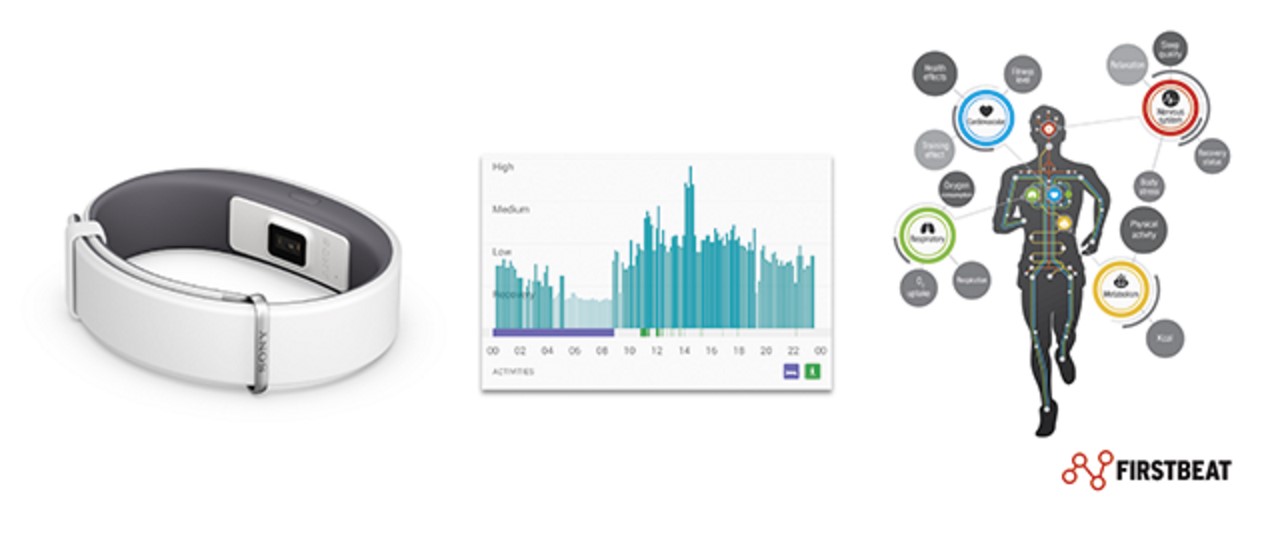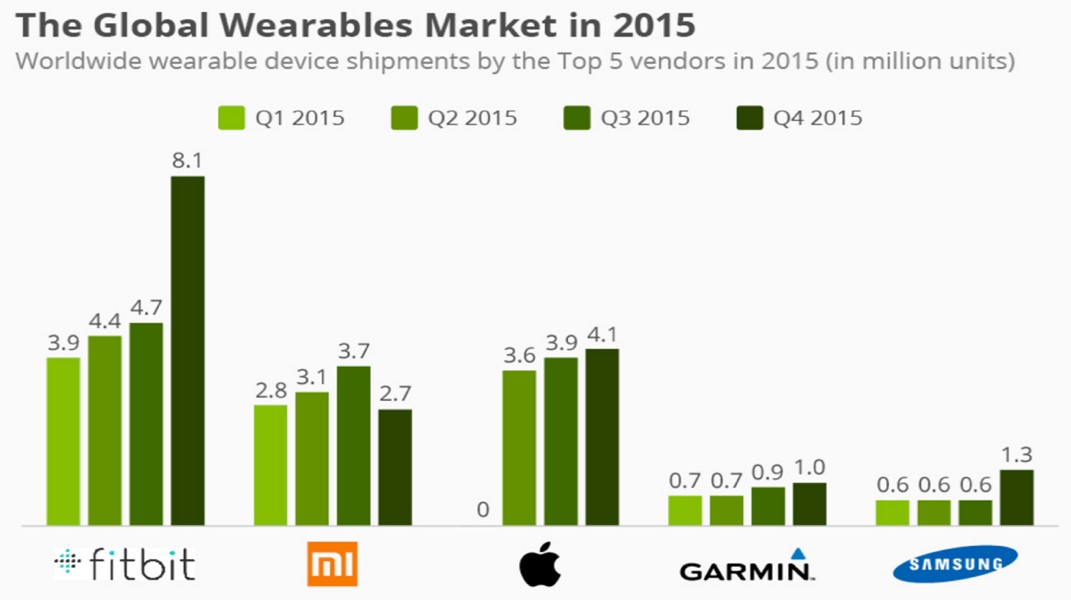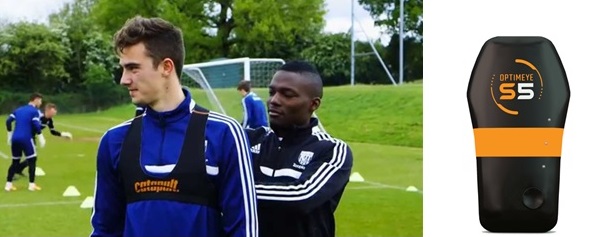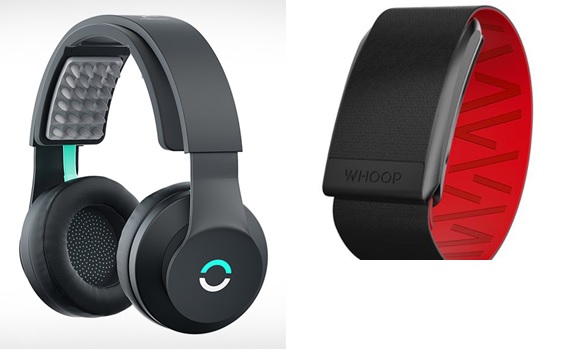Wearable technology is playing a growing role in sport all over the world, used to help coaches, trainers and general managers maximize player performance. While on work experience, Daniel Fernandes (Yr12 student) of The Bishop’s Stortford High School explored how ‘wearables’ are shaping the future of sport.

The wearable technology industry is growing at an extremely rapid rate, currently selling $14bn worth of wearables and expected to increase to $34.2bn by 2020. Everyday new wearable tech, commonly referred to as ‘wearables’, is released; and people are buying them. The range of wearable technology is vast, with some established businesses (Tommy Hilfiger), offering solar powered jackets that act as portable chargers, and some smaller businesses (Future Interfaces Group) enabling you to use your skin as a touchpad, with their new technology- SkinTrack. The range of wearable technology is truly extensive.
Therefore, with huge advancements in the wearable technology available, big industries, especially sport, will naturally begin to invest into more sophisticated pieces of tech. Even for the general consumer, it is clear that an increasing number of people are purchasing into the wearables market (as the figure below shows). With such high expectations in sport, it comes as no surprise that well-defined organizations are implementing the use of ‘wearables’ to further enhance themselves.

However, should it be allowed? To answer this question, we have to explore the impact wearable technology is having on the top sporting organizations and how they are using wearable technology.
Wearable technology in sport?
Sport as an industry is entirely competitive. Whether it’s a junior Sunday morning football game or a world cup final, people want to win in sport. However, unlike in many other industries, where winning is the main goal, sport is vastly random. But, with more and more advancements in technology sport can be increasingly predictable as wearable technology can provide an extensive analysis of a player’s match day performance and training routine, while also being able to measure their sleeping patterns and calorie intake. A scientific evaluation of this data could lead to an improvement in performances, ensuring that players perform to the best of their ability.
The premier league, which is worth more than £5bn in TV licenses alone, has seen top teams, such as Leicester City and Southampton FC begin to use wearable tech and the results appear to be significant. In January, roughly the halfway point of the season, Leicester City’s players (at the time 2nd in the league) had missed a total of 184 days through injury. Whereas other top teams such as Manchester City (3rd place at the time) had a total of 769 days missed through injury. Furthermore, the Manchester City’s starting team have a net worth of over £233m and the Leicester City starting 11 have a net worth of just under £23m so you may perhaps be wondering how on earth this is happening, as Manchester City most likely have better facilities, medical staff and money to spend.
Many say luck is the leading factor for explaining Leicester’s success, however, not even luck can cause a team, worth 10 times less, to consistently outperform its rivals and stop its players from getting injured. The main difference between these two leading football clubs, apart from Manchester City’s unlimited resources, is that Leicester City Football club have implemented the use of the latest wearable tech available to the sporting industry, Catapult Sport's OptimEye S5 device, which can be seen below. This device is responsible for measuring acceleration, direction, position and, crucially, the impact of collisions. The use of wearable tech has proven to be extremely successful and once more associations understand the use of wearables, and particularly its enormous benefits, therefore sports in general could vastly change.

How has wearable technology affected sporting industry?
The use of wearable technology is increasing each day, a rising number of professional athletes are adopting the newest tech, and the once non-existent demand for wearable tech is now immense. The NBA is where some of the most successful athletes, such as Steph Curry, are implementing the use of wearable tech into their training, with Curry particularly using the ‘Halo Sport Headphone’ (pictured below left) which stimulates the brain to increase effectiveness in a training session. Yes, neuroscience is now wearable.

However, the NBA is especially keen on banning the use of wearable tech in professional games; in the past year a professional basketball player (Matthew Dellavedova) was caught using the wearable ‘Whoop’ (pictured above right) and banned from ever strapping it on again. This particular device is made for elite athletes as it monitors heart rate and stress levels amongst other things and allows the player to instantly change his performance based on the live feed of results, during a game.
This raises the question, why the largest sporting corporations are so reluctant to allow the use of technology that is simply there to allow someone to reach their maximum potential, in professional games. Perhaps, its because the rules behind the use of new technology in sports are years behind the advancements being made by some of the leading wearable tech companies, such as Fit-Bit. However, it is understandable that the NBA are afraid of the direct impact wearables may have on their extremely lucrative (generated over $5bn in 2014/15 season) business. Alternatively, there is the possibility for money to be made if wearables can be implemented correctly, as some fans thoroughly enjoy deep analysis of games.
The future of wearable tech in sports
The future of sport is, as sport is in nature, extremely challenging to predict. From the introduction of ‘Goal-line’ technology in Football, to the use of ‘Hawk-eye’ in Tennis, and even ‘hot pants’ used in cycling (which were inspired by Formula One’s tyre warmers), sport has vastly evolved over the last decade.
However, the use of wearable tech appears to be one of the greatest breakthroughs in the past century. The use of wearable tech could very much mimic the technology used in formula one teams; as it could provide a constant analysis of a player’s performance and could provide continuous feedback from the sidelines. The use of wearable technology could be vital in enabling players to perform to the highest standards, as it does for Formula One drivers.
On the other hand, we seem to neglect the impact the use of wearables, and the constant monitoring of performances has on individuals. Brian Bulcke, a professional American football player has said “I feel like a guinea pig sometimes when we talk about athletes and technology, and I stress that we’re people too”. This suggests perhaps some athletes would not perform to the best of their ability, with the aid of extensive analysis of performances as there is a great psychological side-effect, of being highly scrutinized on a regular basis, on the individuals. Furthermore, sport is an entertainment business, and not everyone is a fan of statistical analysis and robot like actions, many sporting fans enjoy the randomness and luck that play a role in the outcome of sporting events.
Therefore, it is possible that the use of wearable technology may not be used extensive in the future of sports, however, it most certainly could be. Especially with the wearables market expected to grow at a compound annual rate of 35% over the next five years, reaching an estimated 148 million units shipped in 2019. Overall, the range of wearable technology has advanced to a level where it genuinely is useful and could be used to improve our lives, especially in professional sports.
Sources:
http://www.wired.com/2016/05/device-turns-arm-touchpad-heres-works/
http://www.bbc.co.uk/news/business-36036742
https://www.statista.com/chart/4423/wearable-device-shipments-2015/
http://www.bbc.co.uk/sport/football/35313650
http://www.wareable.com/sport/nba-star-caught-out-using-banned-wearable-during-games-2558
http://www.statista.com/statistics/193467/total-league-revenue-of-the-nba-since-2005/